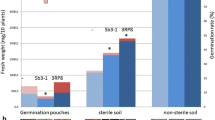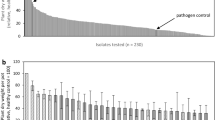Abstract
Two field experiments were carried out at the UAPNPBS experimental station, Seropédica, with two sorghum and one rice cultivars. The establishment, and inoculation effects, ofAzospirillum spp. andHerbaspirillum strains marked with antibiotic resistance were investigated. One grain sorghum (BR 300) and one sugar sorghum (Br 505) cultivar were used.Azospirillum lipoferum strain S82 (isolated from surface sterilized roots of sorghum) established in both cultivars and comprised 40 to 80% of theAzospirillum spp. population in roots and stems 60 days after plant emergence (DAE).Azospirillum amazonense strain AmS91 (isolated from surface-sterilized roots of sorghum) reached only 50%. At 90 DAE, S82 almost disappeared (less than 30% of establishment) while the establishment of AmS91 remained constant in roots and stems. No establishment ofH. seropedicae strain H25 (isolated from surface-sterilized roots of sorghum) orA. lipoferum strain S65 (isolated from the root surface of sorghum) could be observed on inoculated roots. Inoculation with S82, AmS91 or S65 but not withH. seropedicae H25, increased plant dry weight of both cultivars and total N in grain of the grain sorghum. In rice,A. lipoferum Al 121 andA. brasilense Sp 245 (isolated from surface sterilized rice and wheat roots respectively) established in the roots but there was no increase inAzospirillum spp. numbers due to inoculation. None of the strains affected plant growth or rice grain yield.Azospirillum amazonense, A82 andH. seropedicae Z95, which did not establish in roots, significantly enhanced seed germination.
Similar content being viewed by others
References
Baldani J I 1984 Ocorrência e caracterização deAzospirillum amazonense em comparação com as outras espécies deste gênero em raïzes de milho, sorgo e arroz. Rio de Janeiro, Universidade Federal Rural, MSc. Thesis.
Baldani V L D and Döbereiner J 1980 Host plant specificity in the infection of cereals withAzospirillum spp. Soil Biol. Biochem. 12, 433–439.
Baldani V L D, Baldani J I and Döbereiner J 1983 Effect ofAzospirillum inoculation on root infection and nitrogen incorporation in wheat. Can. J. Microbiol. 29, 924–929.
Baldani V L D, Alvarez M A B, Baldani J I and Döbereiner J 1986 Establishment of inoculatedAzospirillum spp. in the rhizosphere and in roots of field grown wheat and sorghum. Plant and Soil 90, 35–46.
Baldani V L D, Baldani J I and Döbereiner J 1987 Inoculation of field grown wheat withAzospirillum spp in Brasil. Biol. Fertil. Soil 4, 37–40.
Boddey R M, Baldani V L D, Baldani J I and Döbereiner J 1986 Effect of inoculation ofAzospirillum spp on nitrogen accumulation by field-grown wheat. Plant and Soil 95, 109–121.
Boddey R M et al., 1987 Methods for the study of nitrogen assimilation and transport in grain legumes. MIRCEN J. 3, 3–22.
Döbereiner J 1983 Ten yearAzospirillum. In Azospirillum: Genetics, Physiology, Ecology. Ed. W. Klingmüller. pp. 9–23. Experientia Supplementum 48. Basel.
Döbereiner J and Pedrosa F O 1987 Nitrogen Fixing Bacteria in Nonleguminous Crop Plants. 155 pp. Brock/Springer Series in Comtemporary Biosciences. Science Tech Publishers, Madison.
Kapulnik Y, Kiegel J, Okon Y, Nur I and Henis Y 1981a Effect ofAzospirillum inoculation of some growth parameters on N-content of wheat, sorghum andPanicum. Plant and Soil 61, 65–70.
Kapulnik Y, Sarig S, Nur I, Okon Y, Kigel J and Henis Y 1981b Yield increases in summer cereal crops in Israeli fields inoculated withAzospirillum. Expl. Agric. 17, 179–187.
Kapulnik Y, Okon Y and Henis Y 1987 Yield response of spring wheat cultivars (Triticum aestivum andT. turgidum) to inoculation withAzospirillum brasilense under field conditions. Biol. Fertil. Soils 4, 27–35.
Kapulnik Y et al., 1982 The effect ofAzospirillum inoculation on growth and yield of corn. Isr. J. Bot. 3, 247–256.
Lin, W, Okon Y and Hardy R W F 1983 Enhanced mineral uptake byZea mays andSorghum bicolor roots inoculated withAzospirillum brasilense. Appl. Environ. Microbiol. 45, 1775–1779.
Okon Y 1982Azospirillum: Physiological properties, mode of association with roots and its application for the benefit of cereal and forage grass crops. Isr. J. Bot. 31, 214–220.
Okon Y 1985Azospirillum as a potential inoculant for agriculture. Trends Biotecn. 3, 223–228.
Sarig S, Kapulnik Y, Nur I and Okon Y 1984 Response, of non-irrigatedSorghum bicolor toAzospirillum inoculation. Expl. Agric. 20, 59–66.
Smith R L, Schank S C, Milan J R and Baltensperger A A 1984 Response of sorghum and pennisetum species to the N2-fixing bacteriaAzospirillum brasilense. Appl. Environ. Microbiol. 47, 1331–1336.
Thomas Banzon D, Weinhard P, Villecourt P and Balandreau J 1982 The spermosphere model. I. Its use in growing, counting and isolating N2-fixing bacteria from the rhizosphere of rice. Can. J. Microbiol. 28, 922–928.
Author information
Authors and Affiliations
Rights and permissions
About this article
Cite this article
Pereira, J.A.R., Cavalcante, V.A., Baldani, J.I. et al. Field inoculation of sorghum and rice withAzospirillum spp. andHerbaspirillum seropedicae . Plant Soil 110, 269–274 (1988). https://doi.org/10.1007/BF02226807
Issue Date:
DOI: https://doi.org/10.1007/BF02226807




